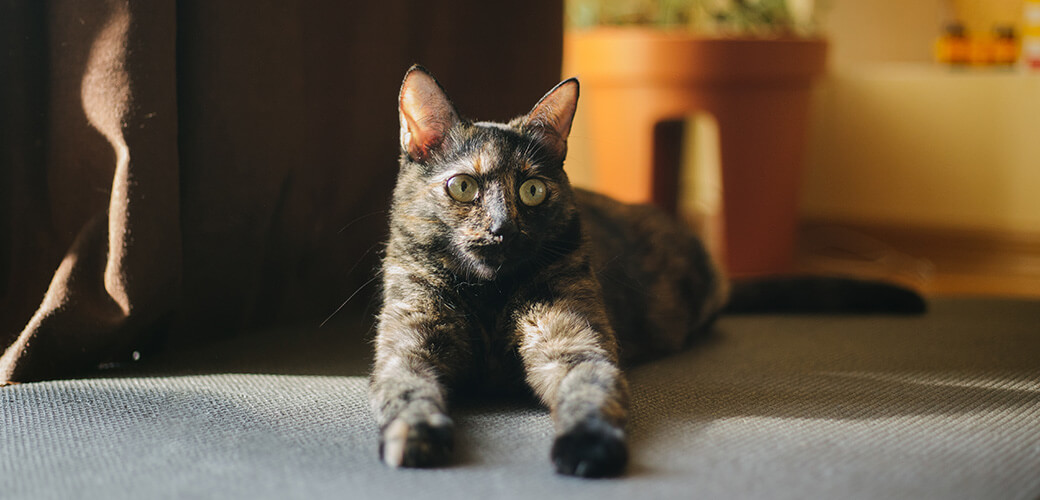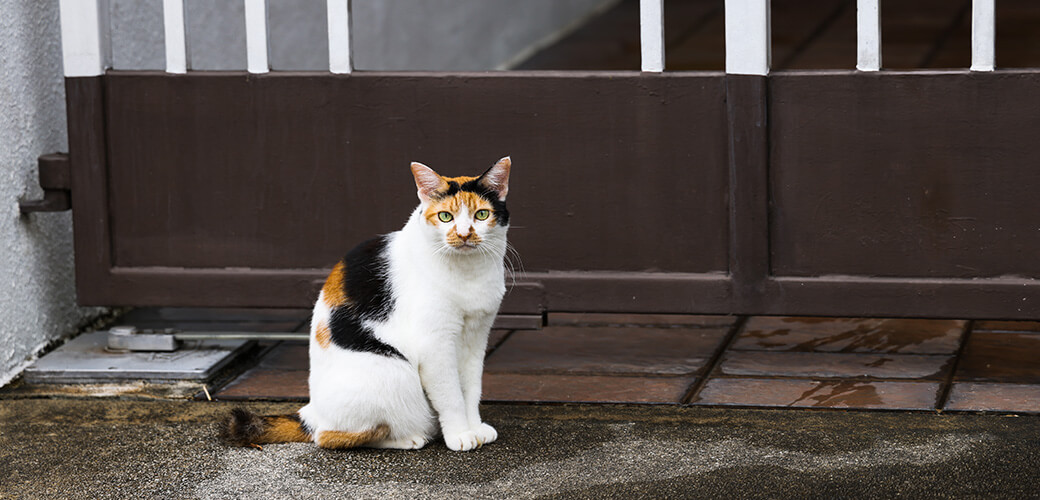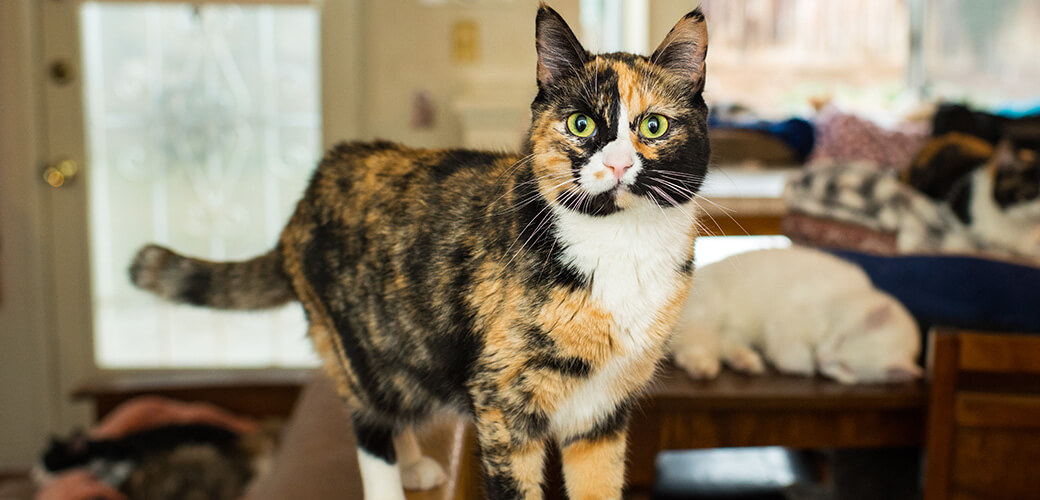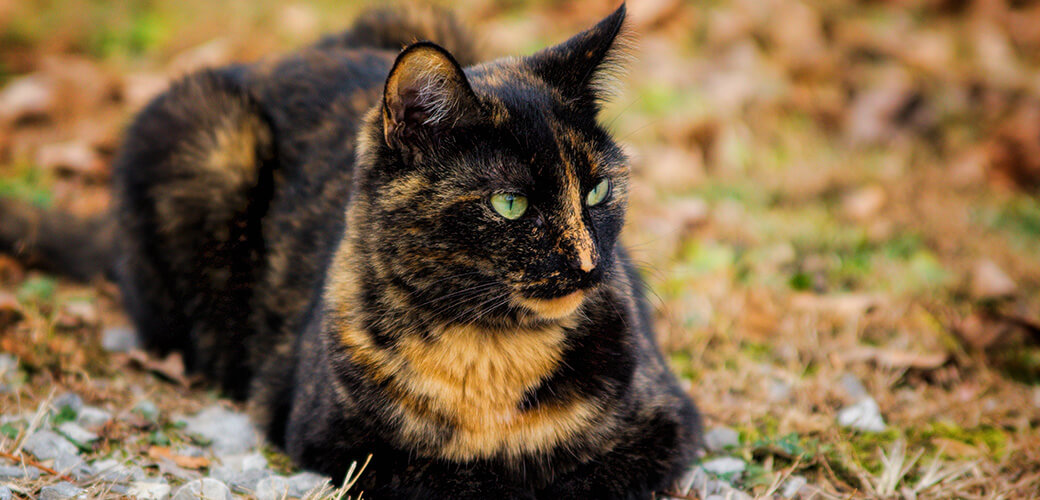Tortoiseshell and Calico cats are both breed variations that display beautiful coat coloring, mixing several colors and tones to create something eye-catching. You’ll never know what color your Tortie or Calico tabby cat will truly turn out until they’re grown, but they are always extremely pretty and unique.
An interesting fact is that Tortoiseshell cats and Calico cats are almost always females. This is because the unique coloring of both breed variations is related to the X chromosome. For a cat to be tri-colored or black and orange, they need to have two X chromosomes, which means they’ll also be female. Having a truly tri-colored male cat is highly unusual, but a genetic mutation could make it possible. That’s the simple explanation behind the link, anyway. To learn more about Torties and Calicos and understand ways to identify each breed variation, keep on reading!
Tortoiseshell vs. Calico: Learning the Difference
The issue with starting to identify Tortoiseshell cats and Calico cats is that they are often seen as individual breeds. But that is not what they are. A Tortoiseshell and a Calico are breed variations based on a cat’s coat colors and patterns. A British Shorthair can be a Calico or a Tortoiseshell cat, as long as they have the correct coloring for either variation and genetic markers.
“Calico” and “Tortoiseshell” refer to the cat’s coat, not their breed. In the cat world, a British Shorthair is a British Shorthair. A British Shorthair with Calico markings is still a British Shorthair, they just have a Calico-style coat and the genetics to be a tri-color cat.
What are Tortoiseshell cats?

Tortoiseshell cats are any cat breed with tortoise-shell markings. This means that the cat is mostly black, with mottled or particolored shell colors that look like they’ve come straight off a tortoise. The most common colors of a Tortoiseshell cat are black and orange, with a shifting range of these colors blending throughout their coat.
They usually have a brindle-style coat, and the Tortoiseshell coloring can appear in purebred, crossbreed, and other cat types. They’re almost always female cats, but it is possible (though extremely rare) to have a male cat with a Tortie pattern. If there is a male cat with this pattern variation, they are usually sterile because of the genetic mutation. Male Torties appear every 3000 cats or so.
Torties are distant, feisty, and have strong personalities. These traits may be tempered by the personality traits of whichever breed they are, so it’s possible to have a calmer and more loving Tortie for a cat person to love.
What are Calico cats?

These two variations are so often mixed up because the main difference between their coloring is that Calico cats have white patches, while Torties usually don’t. Both cats share coat patterns full of black and orange, both can have tabby patterns or not, and both can have diluted coats where the black becomes gray. It creates confusion, but there’s an easy way to tell them apart.
When you come across a cat that you think is a Calico rather than a Tortie, look for the obvious Calico coloration. This is represented as large patches of white anywhere on the cat. Torties aren’t white anywhere on their coats, but the Calico color pattern isn’t complete without some white.
Why are the Cat Breeds so Similar?
As we mentioned at the start of the guide, for a cat to be either 1. Tri-color, or 2. Black and Orange must have the correct color genes. These genes are directly tied to the cat’s X chromosome, so most felines with Tortie or Calico coloring are female cats, not male cats.
Tabby markings are also found in coat variations, allowing Tortie-Tabbies and Calico-Tabbies to exist. You get a Tortie or Calico with Tabby markings or even spots of red/orange fur in their coat.
How Tortoiseshell cats and Calico cats get their patterns
We’ve glossed over the color genetics of Tortoiseshell and Calico patterns a few times, so let’s explain how it works.
As we mentioned, most of these variations are female cats because one of their X chromosomes will carry the orange (XO) gene, and the other will carry the black (XB) gene. How do male Tortoiseshell and calico cats exist, then? Male Torties and Calicos usually have three chromosomes, having inherited an extra X chromosome where one isn’t needed because they have a Y chromosome. Male Calicos and Torties usually suffer from health issues and are sterile.
Here’s how Calicos and Torties appear in cat genetics:
- Female XO + Male XO = orange
- Female XO + Male XB = mixed orange+black pattern
- Female XB + Male XO = mixed orange+black pattern
- Female XB + Male XB = black
Thanks to how the color genes are connected to the chromosomes, it’s possible to have an orange tabby that gains Tortie or Calico coat coloring.
The addition of white in the coat, as seen in the Calico but not in the Tortoiseshell cat, is down to the piebald gene. This is expressed on a different chromosome to orange or black and has no color attached, creating the white spots on Calico cats. The Piebald gene is dominant over black and orange, but both other colors still exist in the cat’s genetics.
Difference Between Calico and Tortie Cats

It’s important to remember that Calico cats and Tortie cats are coat colors and patterns rather than the breed of the cat. Whether your cat is Tortoiseshell, Calico, or tabby patterned, you’ll notice some coat and personality differences.
If the cat is ginger, black, or white, they’re a Calico. Black and orange with a tortoise shell-like pattern, they’re a Tortie. And if they have stripes without patches, they could be a simple tabby cat.
Dilute Tortie vs. Dilute Calico
Dilute Tortoiseshell cats have coats with just two colors and diluted pigmentation. Appearance-wise, this means that they can look gray rather than black. The black cat pigment genes are diluted in these Tortoiseshell cats, giving them a gorgeous coat color that is something really special.
Similarly, a Dilute Calico cat has the same “issue” with their coloration. What should be black on their coat is gray instead. Dilute Calico, and Tortie cats don’t have any health issues that regular Calico and Tortoiseshell cats have. The only difference is the absence of black patches, which are replaced by silvery gray tones.
Common Tortoiseshell Cat Breeds

- American Shorthair
- British Shorthair
- Cornish Rex
- Maine Coon
- Persian
- Common Calico cat breeds
- American Shorthair
- Arabian Mau
- British Shorthair
- Exotic Shorthair
- Japanese Bobtail
- Manx
- Norwegian Forest Cat
- Persian
- Siberian
- Turkish Angora
- Turkish Van
FAQs:
Q: Is a Tortie or a Calico better for new cat owners?
A: Calico cats tend to be a little more friendly than Tortoiseshell cats, though they are both very loving creatures. The Tortie cat has a bit of a no-nonsense attitude as a domestic pet, so homes with children may prefer the playful Calico cat over the more stoic Tortoiseshell cat. New pet parents should be made aware that the coat color of their cat will have little to do with their personality, though. Instead, consider the breed of the cat. For example, both American and British Shorthairs have Torties and Calico cats, and they are very good beginner breeds to own.
Q: Do Tortoiseshell and Calico cats both have tabby markings?
A: Neither cat typically has the markings we associate with tabby cats. It is, however, possible to have a Tortie-Tabby and a Calico-Tabby. Tabby kittens may also occur in litters with a Tortoiseshell or a Calico cat. There’s a lot of genetics involved in the hows and whys, but you need to know that the tabby pattern is not common in either breed. A cat with Tabby and Tortoiseshell patterns are referred to as a “Torbie” cat.
Q: Can you have a male Tortie cat?
A: It is possible for a male Tortoiseshell cat to be produced, but they are very rare. Approximately one in every 3,000 Tortie cats is male because genetics dictates that a tri-colored cat is most likely to have two X chromosomes as opposed to one X and one Y. This is because the tri-color gene is linked to the X and not the Y chromosome.

